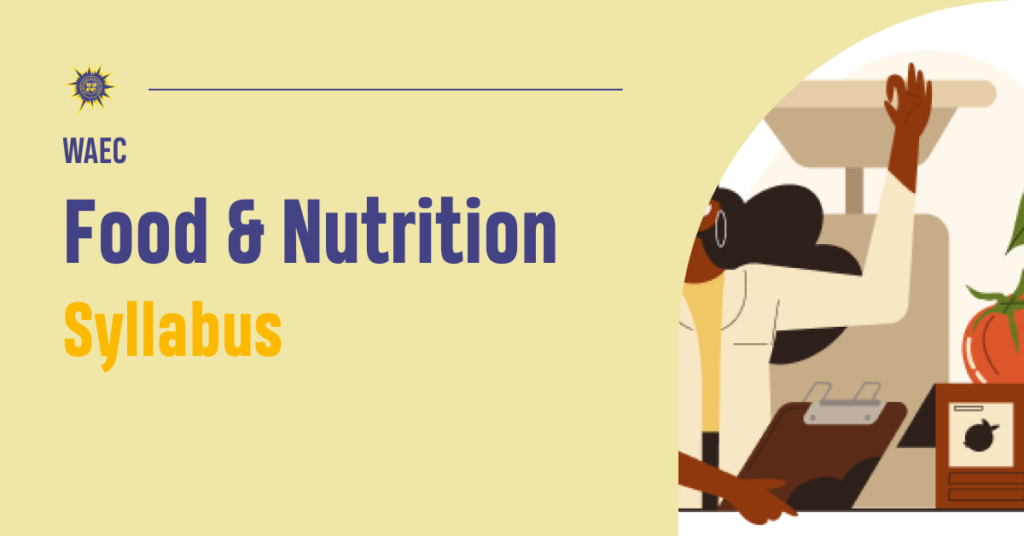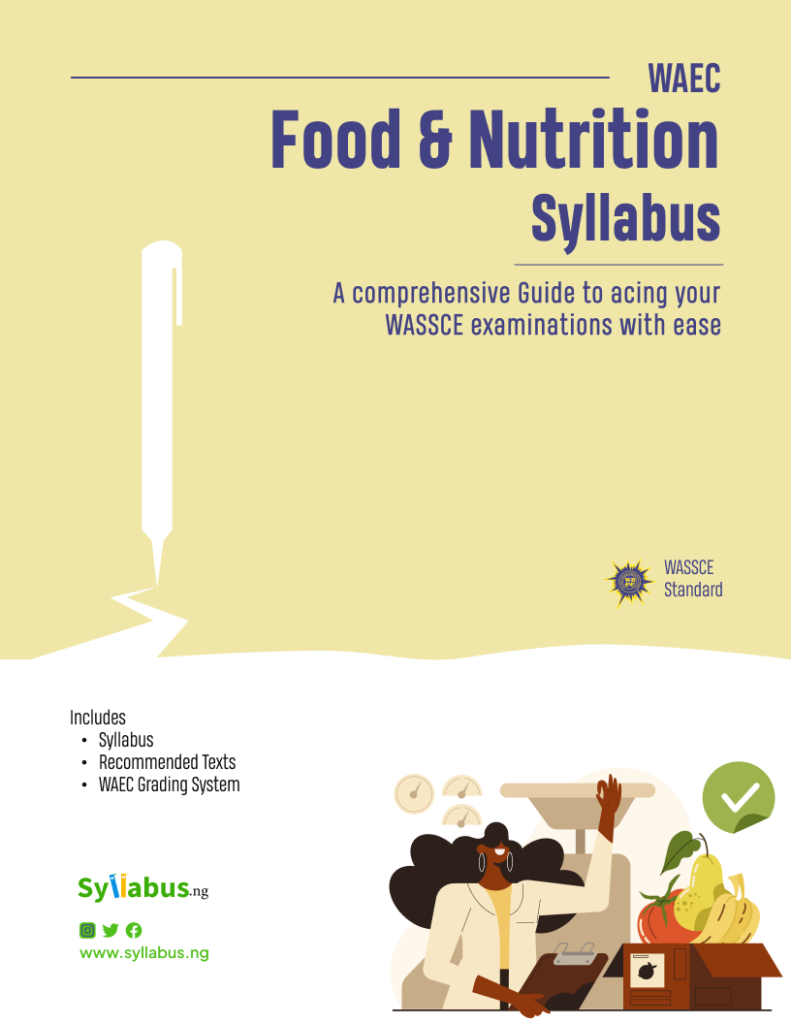Get straight A’s when you download and study with this Food and Nutrition Syllabus for WAEC.

Home » WAEC Syllabus » WAEC Food and Nutrition Syllabus
If your food and nutrition exams are fast approaching and you are confused about what to read for the exams.
Then this article is for you.
This WAEC syllabus for Food and Nutrition tells you all you need to know about the upcoming exams. From the topics to the objectives down to the recommended textbooks, you can read with. It’s a valuable resource for you and your classmates so do well to share this with them.
Reading this syllabus and practicing your past questions will give you an edge over other candidates who focus on just their school notes and materials.
There will be three papers, Papers 1, 2, and 3 all of which must be taken. Papers 1 and 2 will be composite paper and will be taken in one sitting.
PAPER 1: This will comprise sixty multiple-choice questions, all of which are to be answered within 1 hour for 60 marks.
PAPER 2: This will comprise six essay questions out of which candidates will be required to answer four. The paper will carry 40 marks and will last 1 hour and 15 minutes.
PAPER 3: This will be a practical test of 3 hours duration. It will carry 100 marks and will be conducted by a visiting examiner.

Excelling your WAEC Food & Nutrition exam starts from knowing what’s expected of you.
Don’t be left behind. Download the Syllabus today.
| WAEC FOOD & NUTRITION SYLLABUS | |
| TOPICS | OBJECTIVES |
| NUTRITION & HEALTH | i. Introduction to Foods and Nutrition (a) Meaning (b) Basic knowledge of Nutrition (c) Importance of Human Nutrition (d) Factors affecting Foods and Nutrition (e) Food Habits ii. Careers associated with Foods and Nutrition. (a) Careers associated with Foods and Nutrition (b) Factors that influence career choices (c) Characteristics required for Foods and Nutrition careers iii. Basic Food Nutrients (a) The nutrients and their nutritive values (b) Functions of the different nutrients (c) Sources of the different nutrients (d) Dietary deficiencies (e) Metabolism, (digestion and absorption of foods carbohydrate, protein and fat) (f) Knowledge and use of food composition table (g) Food tests: simple physical and chemical tests of food stuffs to detect presence of nutrients in foods e.g. proteins, fats and carbohydrates iv. Meal Management a) Meal Planning (i) Meal planning terms (ii) Reasons for planning meals (iii) Factors in planning meals (iv) General principles of meal planning (v) Meal patterns b) Special Nutritional Needs (i) Nutritional needs for different groups e.g. pregnant, lactating mothers, infants and children, adolescents, adults and the aged, vegetarians. (ii) Planning meals for people in health condition e.g. HIV & AIDS, invalids, convalescents, overweight, underweight, hypertension, diabetes etc |
| FOOD LABORATORY & EQUIPMENTS | i. The kitchen (a) Types of kitchen e.g. traditional, modern, institutional. (b) Planning different types of kitchen. (c) Factors to consider when planning. (d) Cleaning agents and abrasives (commercial and local) ii. Kitchen equipment and tools (a) Classes and types of equipment (b) Selection, use, care and storage of large and small equipment, fixtures and appliances iii. Safety in the kitchen (a) Types of kitchen accidents (b) Causes and prevention of accidents (c) Content and use of first aid box (d) Simple first aid treatment iv. Sanitation in the kitchen (a) Personal Hygiene (b) Kitchen Hygiene e.g. general cleaning, waste disposal, pests and pest control (c) Food hygiene e.g. handling of foods, food borne diseases, food sanitation laws |
| FOOD COMMODITIES | i. Animal and animal products – milk and milk products e.g Cheese, yoghurt, eggs, meat, poultry, fish etc. a) Kinds/types and structure -Selection -Storage ii. Cereals/grains (a) Kinds and forms (b) Importance of cereals and grains: – versatility – thickening – cheap source of energy/good source of roughage iii. Fruits and vegetables (a) Classification of fruits/Classification of vegetables. (b) Structure, nutritive value and storage. (c) Important of fruits and vegetables in the diet, etc iv. Legumes and oily seeds (a) Classification of legumes, oily seeds (b) Importance of legumes and oily seeds in the diet, etc. v. Fats and oils (a) Kinds and classification – vegetable fats and oils – animal fats and oils (b) Uses in diet (c) Uses in the body (d) Health implications of fats and oils vi. Starchy roots and plantain (a) Types of starchy roots (b) Types of plantain (c) Types of dishes |
| FOOD STORAGE & PRESERVATION | i. Food spoilage (a) Meaning of food spoilage (b) Causes and agents of food spoilage ii. Food preservation (a) Meaning and importance of preservation (b) General principles underlying food preservation (c) Methods of food preservation iii. Food storage (a) Meaning and importance of food storage (b) Storage of perishable and non perishable foods (c) Storage space and equipment e.g. refrigeration, deep freezer, cupboards, shelves, granaries, barns etc |
| FOOD PREPARATION | i. Principles underlying cooking (a) Explanation of the concept of cooking (b) Reasons for cooking food ii. Methods of cooking (a) Moist heat methods e.g. boiling, stewing, steaming etc. (b) Dry heat methods e.g. baking, roasting, grilling, frying etc. (c) Effects of heat on different food commodities e.g. animal products, cereals and grains, fats and oil etc iii. Transfer of heat Methods of heat transfer and meaning – Convection – liquid, gases – Radiation – space – conduction – solid metal iv. Cooking terms Explanation of cooking terms v. Food additives (a) Definitions (b) Types of food additives (c) Functions of additives (d) Selection and use of additives (e) Food adulteration vi. Flour Cookery and Confectionery a) Types of flour •Types of flour •Ingredients in flour •Uses of flour b) Basic ingredients in Flour cookery – Flour, fat, sugar, eggs c) Raising agents •Types of raising agents, i.e., steam, carbon dioxide and air •Sources:- boiling liquid – steam, baking powder – carbon dioxide whisking – air d) Batters and doughs • Batters (Types, Uses of batters. Dishes using batter) • Doughs ( biscuits, classification, rubbed in, creamed, whisked, melted, sponge mixtures) e) Cakes (rubbed in, creamed, whisked, melted, sponge mixtures) f) Pastries •Types of Pastries (Shortcrust, suet, flaky, etc.) •Principles underlying pastry making •Pastry dishes e.g. turn over; jam tartlets, cornish pasties, etc. g) Yeast Mixtures •Definition •Ways of preparing yeast mixture •Important points in preparing yeast mixture •Yeast dishes – bread loaves, bread rolls, doughnut h) Cake Decoration icing •Types of icing e.g. butter icing, royal icing •Uses of icing •Preparation of icing •Using royal icing and butter icing |
| BEVERAGES | i. Classification of beverages (a) Non-alcoholic beverages (coffee&tea, cocoa drink, milk & egg drinks, fruit juices & fruit drinks, beef tea & lemon grass) (b) Alcoholic (beer, wine) ii. Importance of beverages a) Nutritive value iii. Principles underlining the preparation of a beverage a) Tea, coffee, cocoa, etc |
| CONVENIENCE FOODS | i. Types of convenience foods ii. Selection and uses of convenience foods iii. Advantages and disadvantages of using convenience foods iv. Preparation of dishes using convenience foods |
| RECHAUFFÉ (LEFTOVER) FOODS | i. Explanation ii. Importance of using leftover goods iii. Rules/guidelines for using leftover foods iv. Rechauffé dishes 9. Festive Dishes/Special Occasion Dishes i. Explanation ii. Occasions for festive dishes iii. Types of festive dishes/special occasion dishes iv. Preparation of festive dishes/special occasion dishes |
| FESTIVE DISHES / SPECIAL OCCASIONS DISHES | i. Explanation ii. Occasions for festive dishes iii. Types of festive dishes/special occasion dishes iv. Preparation of festive dishes/special occasion dishes |
| ART OF ENTERTAINING | i. Entertainment (a) Explanation (b) Types of parties (c) Occasions for parties (d) Points to consider when selecting types of parties (e) Factors that contribute to the success of parties ii. Table setting and etiquette (a) Explanation e.g. table setting, cover, etc (b) Setting tables and tray for different meal and occasion (c) Table appointments (d) Table manners/etiquette iii. Meal Service Style (a) Types of meal service – Informal meal service – formal meal service (b) Factors determining choice of service styles types of party (c) Foods for special occasions e. g. birthday, naming ceremonies, weddings etc. (e) Factors that contribute to the success of parties |
| EXPERIMENTAL COOKERY | i. Research into Local dishes and Drinks (a) Importance of research in Foods and Nutrition (b) Collection of information (data) (c) Research into local dishes (d) Development of new recipes (e) Improving existing recipes based on methods of preparation, Nutritive value, time and energy use and service/ presentation ii. Experiments (a) Using fruits e.g. passion fruit, samia, royal palm fruit (b) Other types of flour e.g. root, cereal and legumes, etc |
| CONSUMER EDUCATION | i. Consumer Education (a) Meaning and principles (b) consumer agents ii. Food Budgeting (a) Explanation (b) Factors to consider when budgeting iii. Food Purchasing (a) Guidelines for shopping for food (b) Guidelines for bulk purchasing (c) Reasons for buying in bulk (d) Advantages and disadvantages of bulk purchasing |
| SELF – EMPLOYMENT | i. Setting up and managing a catering enterprise (a) Explanation of terms – entrepreneur – entrepreneurship – enterprise (b) Characteristics of an entrepreneur (c) Advantages and disadvantages of an entrepreneur (d) Setting up a catering entrepreneur (e) Some catering enterprises (f) Factors contributing to the success of an enterprise ii. Work ethics (a) Explanation of work ethics (b) Good work ethics iii. Packaging (a) Explanation of Food Packaging (b) Reasons why food is packaged (c) Qualities of packaging materials (d) Types of packaging materials |
All topics outlined in the syllabus above are important and should be given equal attention.
Yes, paper 3 which is the practical section will involve you preparing a select list of meals and you will be graded by an external invigilator.
I don’t think there are any challenging areas in the syllabus. All you need to do is read and understand the topics in the syllabus before the exam and practice past questions.
For paper 1 which is the Objective section, you will required to answer 60 questions and will be scored over 60
For the theory section, you will be scored over 40.
When these two marks are added, it’ll make 100%.
Paper 3 which is the practical section will be graded over 100% as well.
After all is done, your mark will be divided into 2 to get your final grade.
If you’re unsure about a question, skip it and move on to other questions you understand and can answer. Then come back to those you don’t understand and think about it some more. Don’t spend too much time on a question that is confusing you. It’s better to focus on questions that you are more confident about.
Some common mistakes include rushing through the exam, not reading questions carefully, and needing to manage your time well. Remember to cross-check your work and make your writing legible enough.

Excelling your WAEC Food & Nutrition exam starts from knowing what’s expected of you.
Don’t be left behind. Download the Syllabus today.